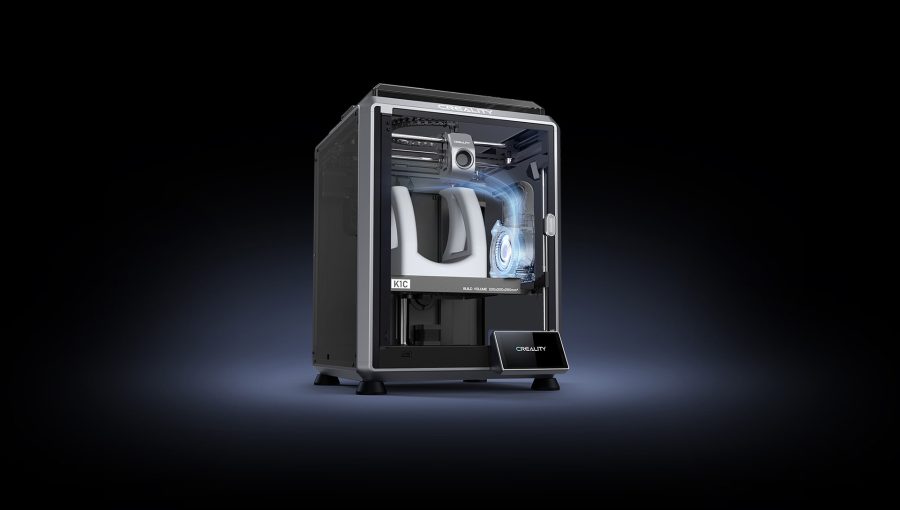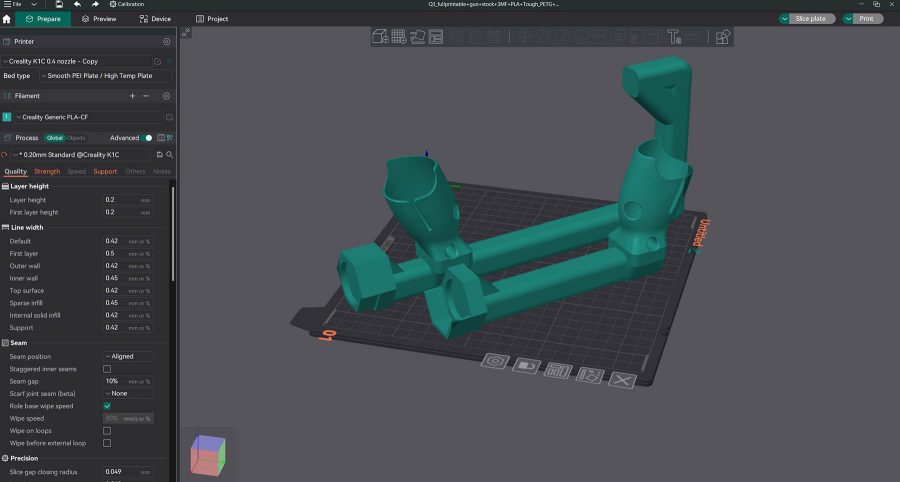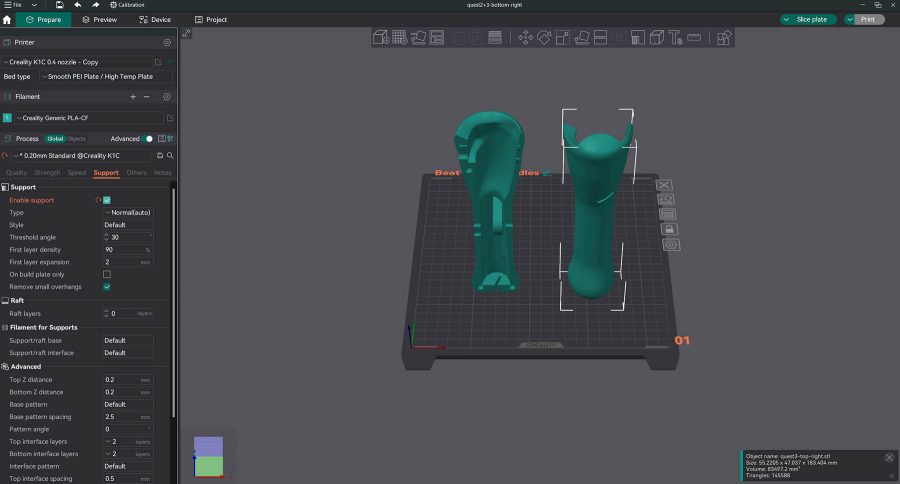We’ve covered various aspects of 3D printing here on ReadWrite over the past few months, mainly looking at how to use different 3D printers. various projects To create the best game room. We have big plans for what we’re going to do in the coming months, but this time we’re going to go over 3D practical objects that will enhance our gaming experience on Meta Quest 3.
The Quest 3 is a great piece of hardware but some corners have been cut to keep the price down. 3D printing and a little knowledge can help fix this, and we can even save a good amount of money on some cool gaming accessories thanks to it.
However, the Quest 3 can be quite an active device and 3D prints aren’t always known for their ability to withstand a lot of abuse. So for this feature, we’re going to be taking on Creality’s new flagship K1C printer, an enclosed core XY machine that’s capable of printing carbon-fiber-infused filament for added strength to create some accessories that will stand the test of time. Must live up to.
How to print carbon fiber filament on a K1C
The best thing about the new Creality machine is that you can print carbon fiber and many other difficult-to-print filaments right out of the box. The machine takes very little work on your part – simply remove the three screws securing the bed to the packing material and transport, and you can hook up and break down the filament of your choice.
I’d never printed with carbon fiber before so I was a little wary about ripping with the roll so I did some test prints first using normal PLA, then using rainbow silk to see what would happen. will be. I had read some comments online that people were having problems with adhesion to the bed and having to use glue sticks, but I haven’t done that, every filament I’ve put in has had not a single failed print, And I’ve printed some very complex shapes.

Creality K1C It is perfect for printing filaments fused with other materials like CF due to its casing and quick swap tri-metal nozzle made of a combo of copper, titanium and hardened steel.
Your average copper nozzle doesn’t like printing with rigid filaments, so you need a hardened steel tip for it to survive. If you feel you need to replace it, the quick swap mechanism similar to Bamboo’s Quick Swap on the Bamboo Lab A1 makes it much less painful than before, it’s not as easy, but nor is it a chore. There is work.
And that, along with an appropriate filament setting in your slicer of choice – I used the OrcasSlicer, which now has a KLC profile, and the filament profile worked perfectly for all types of filaments, including the Creality PLA-CF being used here. Worked from.
3D Printing Quest 3 Accessories in Carbon Fiber on a K1C
I could have printed all of these items in PLA, but I wanted them to be more durable so I didn’t have to print them as often. Additionally, since I started printing with CF filament on the K1C I really like the smoother look of it. Prints come out beautifully and this may become my everyday use filament.
Even though the filament was fresh from the pack, I still had some strings, so I used the new Creality Space Pi filament dryer and dried it for about 15 hours to get better results. The dryer looks suitably futuristic and sits well next to the K1C, which is definitely one of my favorite looking printers to date.
Now, onto the models we used.
Quest 3 Cable Clip
I wanted to start with something simple for my search, but also start with something where strength is important since it’s such a small part. I replaced my Quest 3 head strap with the BoboVR’s head strap which has an external battery. This is great but the wire keeps wandering from the external battery to the Quest 3’s charging port.
I found a set of clips specifically for this head strap on Thingiverse and set out to print them. Because it’s such a small print, 51 minutes later K1C had created a thing (well two things) of fearless beauty. I was impressed with the K1C printing PLA, but it was so smooth and lovely, with so much texture that it felt like I bought it myself, not made it with my own hands.
However fitting the clip was a different matter as it was too tight to fit onto the BoboVR’s strap and trying to force the cable into it caused the clip part to break and fly off. I’m putting all this into a rough model and will revisit it and design it myself next time contributing a little more. I have since printed clips for other things in the same filament with no problems.
quest 3 gun stock

Next I wanted a stronger gun stockpile so was playing games like Contractors Showdown and Into the Radius. I wanted to make a print that I could make entirely out of carbon fiber filament and stick it on with glue. So, I wasn’t looking to buy a steel rod or a bunch of M3 bolts This model on Makerworld The Pab1o90 seemed perfect for the job.
It comes in two parts on a single plate but I faced a problem with the last part. The K1C’s build volume is 220 x 220 x 250 mm compared to the A1’s 256 x 256 x 256 mm, or the other printer I’m using at the moment, the Qidi Q1 Pro’s 245 x 245 x 245 means that the model also Millimeters took a long time to print. I tried to compensate by reducing the However, the hidden flaw in that plan was that it made the holder for the controller 3% smaller than it was supposed to be, so when I came to shove my Quest 3 controller into it, it broke. It still works but it’s annoying.
Again the look of both pieces is majestic and the K1C does a great job of creating a beautiful smooth print. The low production volume in this case is a shame.
Quest 3 Beat Saber Handle

If you’ve played VR then chances are you’ve played Beat Saber, the original rhythm/lightsaber game. I found some handles for Quest 3 on Thingiverse again from nelmo For Beat Saber (and you can use them for golf games too) that extend the Quest 3’s controllers and make them feel like you’re waving a saber around.
Coming as a two-part print with some connecting thingamabobs, these print really nicely in carbon fiber filament. I love the look of the K1C and the handles are a solid addition to my Quest accessories, and I don’t have to buy them on Amazon.
What else can you print on the K1C?
We’ve really only touched on carbon fiber filaments in this section, but the machine is capable of much more than that. Because of its cover and great nozzle, you can easily print TPU if you want to print a rubber-like grip for your controller, or even a protective cover for the unit.
The machine runs a clipper (sort of), it’s a Creality locked-down version, but to its great credit Creality allows you to easily route it and install a fluid or mainsail on it at the same time and so You can get access to all the Clipper variations you know and love.
If you are a beginner then you don’t need to bother with this as Creality Cloud content already comes with more than enough to get familiar with. Installing the app on your phone means you can check the status of your prints from anywhere in the world and if any printing anomalies are detected the built-in AI camera will attempt to stop the print for you.
So, is the K1C the perfect printer for carbon fiber printing?
The K1C is without a doubt a great consumer printer. Creality has done a great job improving the original K1. It’s also my favorite looking 3D printer, partly because it’s so compact, but it’s so compact because the build plate lacks a few extra millimeters.
The website says you can print it or take it out of the box in three minutes. It may be a little tricky but the setup is extremely simple. Even if I think about the printers I was playing with six months ago, we’re getting very close to someone who can just buy a printer and get cracking now . The Creality K1C is a consumer product, not a hobbyist product.
If you need a printer that isn’t just a regular bed slinger, you’ve probably seen the Bamboo Premium line, this is definitely Creality’s attempt to capture that market with this affordable offering, and it definitely Looks like a good option.
If you get the bundle with a filament dryer, you can try to print all but the very exotic filaments, but really, unless you’re running a print farm, you’re best off sticking to the main filaments. Can. Carbon fiber is great for pieces that require a little more than PLA, especially if they withstand heavy wear or need them outdoors, or even if you just want something that Which looks a little less like it was 3D printed.
There are a few issues with the machine that can prevent you from quickly 3D printing. The common filament spool holder on the back is annoying, but Creality offers a model for the spool holder on a USB drive that attaches to the side of the machine. This can really be done but there is still something cool about printing your own solutions.
In fact the lid is the second sticking point. It is not long enough to prevent the Bowden tube from rubbing on it. As always, manufacturers elsewhere have solved the problem by providing models to raise the risers for you, but again, you need to know this, and if you’re new to the hobby…
I think Creality knows this is something that needs to be fixed, they even provide a stretch of protective tape for you to stick on the inside of the lid to keep it from rubbing and marking. Hardly elegant but I guess it’s a stopgap until the problem goes away, possibly the next model to be released.
Overall, whatever you’re printing, whether it’s more models for your game room or gaming accessories for your setup – the Creality K1C is a simple solution that you won’t have to struggle with.
3D printing things that you are going to use in your gaming setup is always more fun than buying them and the Creality K1C allows you to start doing so with minimal hassle.
how-to-make-your-own-meta-quest-3-3d-printed-accessories-on-crealitys-k1c-3d-printer




